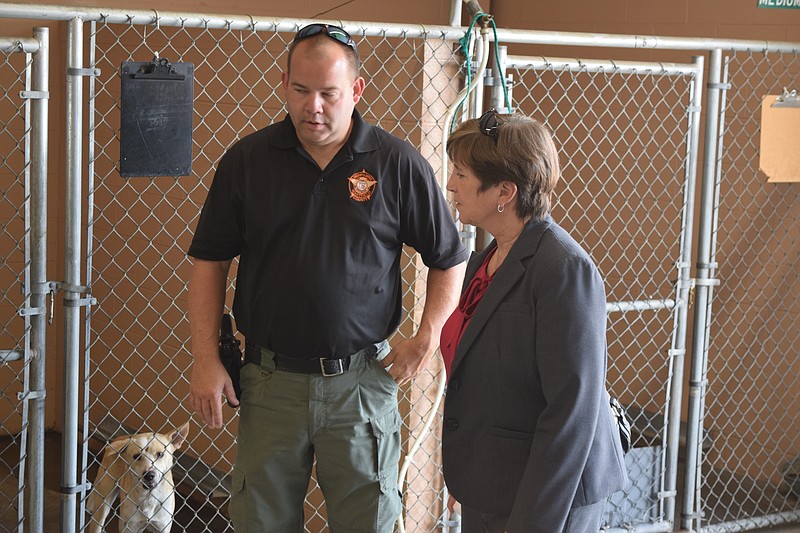DALTON, Ga. - After saving hundreds of dogs and cats from the Whitfield County Animal Shelter, some advocates say they felt rebuffed by county leaders.
In 2016, a group of rescue volunteers began working with the shelter. They pulled out 1,501 animals that otherwise would have been killed, moving them to foster homes and breed-specific kennels across the country. The result was a dramatic drop in the shelter's kill rate.
In 2015, shelter workers euthanized 71.5 percent of the dogs and cats. Last year, the rate dropped to 26.9 percent. And this year, the rate was even better: 7.1 percent from January through May.
Yet volunteer Rebecca Rood, who began working with the county in August 2016, said: "They were not so friendly to anyone volunteering. If you had an issue with the shelter, if you brought up concerns, they would be rude to you."
Rood and other advocates said county officials banned them from commenting on the shelter's Facebook page. And in late May, County Commission Chairwoman Lynn Laughter banned them from going to the kennels in the back of the shelter. Soon, the kill rate crept back up.
In June and July, according to shelter records, the staff's kill rate was 16 percent - more than twice that of the first five months of the year.
Laughter blamed the increase on some volunteers abandoning the shelter, upset with her new policy. The advocates, meanwhile, said her policy broke their trust. The group had complained about the health of some of the animals, and next thing they knew they couldn't seethe animals in their kennels.
"I don't think it was a fracture [in the relationship] as much as it was a, maybe, miscommunication," Laughter said this week. "Or a misinterpretation of a communication."
Now she hopes county leaders can mend the relationship and lower the euthanasia rate again. Shelter Director Don Garrett, often criticized by the advocates, retired earlier this month. Diane Franklin has stepped in as the interim director.
"The negativity has to stop," Franklin said last week. "That is not protecting the animals."
With Laughter's permission, Franklin is allowing volunteers into the kennel area, so long as shelter staff accompanies the visitors. Franklin said she also wants to alert rescue groups when an animal comes to the shelter with a significant injury. As it stands, the county does not supply enough money for the shelter to provide medical treatment for animals found in the community or turned in by owners.
Jan Eaton, of Tri-State Pet Rescue, said she feels encouraged by her conversations with Franklin. But what started the problem to begin with?
Eaton and other advocates say county officials didn't respond strongly enough to their concerns, particularly about animal injuries.
Rood said she found several dogs that needed immediate treatment. One dog lay in the kennel, bleeding. A husky suffered with a broken pelvis, likely having been hit by a car. Another dog, Rood said, had an untreated gunshot wound.
And yet, Rood said, the only way to get medical are was for advocates to take the dogs to a veterinarian.
"I've never seen a shelter who didn't want them to get out," she said. "They truly didn't care how they left, if they were in rescues or in black bags."
Laughter insists she did care, and so did other county officials. She just needed time to improve the shelter. She wanted to pay to train the staff, so they could identify animals' injuries better. She was also happy the euthanasia rate dropped.
But, she said, the advocates were impatient. They didn't care that they saved more animals in 2016 than the year before. They wanted to save all the animals. In Laughter's opinion, their expectations were unrealistic.
And also, she said, some of the advocates became nasty online. She said she read one Facebook post that called her trash, a liar. Another post called for Garrett's death for his "murderous acts" as shelter director.
None of the advocates interviewed by the Times Free Press said they made any of those posts. Still, Laughter said they stoked anger among animal lovers. She believes their access to the kennel allowed them to spread rumors about animal treatment, which is one reason why she banned the public from that area. She later also said they were unsafe with so many animals coming and going.
"There was no patience at all," she said. "And there were too many negative posts."
Asked last week whether they should have taken a different approach with county officials, Eaton laughed last.
"We just exposed them with the facts," Eaton said. "If they can't take it, can't stand the heat, get out of the kitchen. We had the facts. And we were desperate. We begged for months to have some improvements made."
Contact staff writer Tyler Jett at 423-757-6476 or tjett@timesfreepress.com. Follow him on Twitter @LetsJett.
